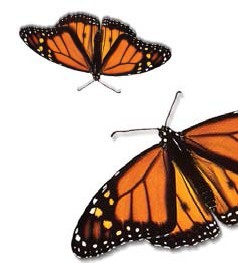Conservationists May Be Literally Killing Monarch Butterflies with Kindness

By Patti Dobranski
Butterflies have fluttered across our skies for about 50 million years. Who doesn't smile when they see their brilliant wing patterns dance in the air among the colors of spring and summer? With beauty that inspired both poets and musicians, they have even graced the world with mystical symbolism.
From a scientific perspective, butterflies are indicators of a healthy environment and play a key role in our ecosystem.
So, it was no surprise that gardeners and conservationists came to the rescue of Monarch butterflies when their population began to decline about 20 years ago. Milkweed plants, the primary food source for Monarch caterpillars, can be toxic to livestock, so farmers often sprayed herbicides over large acreages to kill it. This created a loss of habitat for the milkweed, and consequently, the decline of Monarchs.
In an effort to prevent Monarchs from making the endangered species list, butterfly enthusiasts did what they thought was best: they grew milkweed plants. Turns out, this actually did nothing to help, because gardeners selected the wrong species of milkweed. Instead of solving the problem, they were creating a new one that may be just as harmful to the Monarch butterfly species.
Why are Monarchs Important to our Ecosystem
The most common butterfly species in North America, monarchs are migratory insects that travel to warmer climates like Mexico for the winter months. Their flight patterns carry them over many places where pollination is needed. As pollinators, they are happy to contribute on their journey. Without the Monarchs' help, some of the plant life in these areas may not survive.
Butterflies offer natural pest control. In turn, they are an important element of the food chain as prey for birds, bats and other insectivorous animals. So, bring on the milkweed! Well, the right kind.
The Bite of the Hand that Feeds
Monarch lovers living in the southern United States truly thought they were helping the butterflies by planting an exotic species of milkweed that grows year round. However, they did not realize this particular type of milkweed would harbor a protozoan parasite called Ophryocytis elektroscirrha, or OE, that normally would die off with the cycle of the seasonal, native milkweed. Unfortunately, caterpillars who ate the parasite-infected milkweed often suffered wing deformities when they grew to adulthood as well as shortened life spans. Essentially, the Monarch rescuers had traded one problem for another. But there was hope.
How can we Really Help Monarchs?
Scientists suggested purchasing native milkweed seeds to replenish the population. However, these seeds may be a little more difficult to find than the tropical variety. With the findings emerging that tropical milkweed can be detrimental to Monarch butterflies, the availability of the correct, native milkweed has begun to increase. Environmental researchers also suggest that cutting down the tropical milkweed plants a couple of times during the winter may help control OE parasite.
All of the current research and data have not been received and reviewed at this point. It should be known later this year if the beloved, partner-in-nature Monarch butterfly can avoid making the endangered species list.
Extension Questions
- What other insects are important to our ecosystem?
- What contributory insects are currently on the endangered species list?
- What can we do to get these eco-friendly insects off the endangered species list?